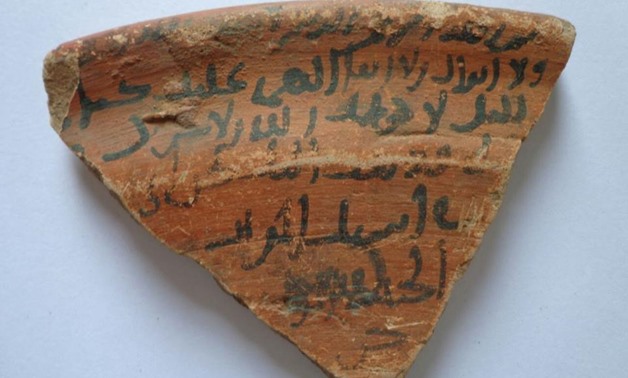
Islamic artifacts being exhibited in the temporary exhibition “Monkey by Four Dinar” in Aswan -Photo courtesy of the Ministry of Antiquities.
CAIRO – 12 April 2018: In collaboration with DAI Kairo (German archeological institute in Cairo), Mohamed Abdel Latif, assistant minister of antiquities for the Islamic, Coptic and Jewish sectors, launched “The Monkey for Four Dinars” temporary exhibition for Islamic antiquities at the Annex Museum on Elephantine Island in Aswan on Wednesday April 11.
Elephantine Island is one of the most significant archeological sites in Egypt that exceptionally depicts the Egyptian history from the ancient era to the Islamic era.
The exhibition’s opening was attended by DAI director and the leaders of the archeological missions working in Egypt as well as other archeologists and specialists. The temporary exhibition includes 300 Islamic artifacts and runs until October 31.
 Islamic artifacts being exhibited in the temporary exhibition “Monkey by Four Dinar” in Aswan -Photo courtesy of the Ministry of Antiquities.
Islamic artifacts being exhibited in the temporary exhibition “Monkey by Four Dinar” in Aswan -Photo courtesy of the Ministry of Antiquities.
“The exhibition’s title refers to the diverse societal and economic details the exhibition presents; such details were not previously mentioned in any historical reference,” Ahmed Kamal from Abel Latif’s media office told Egypt Today.
These clay artifacts help in documenting the Egyptian history, especially the ancient eras. Diverse archeological missions in Northern and Southern Egypt discovered thousands of clay artifacts and based many historical facts on them.
Kamal added that the artifacts, currently placed in the temporary exhibition, indicate the kinds and prices of goods in the Islamic era. He also pointed out that the mission found a clay artifact on which the prices of monkeys at that time are written.
 Islamic artifacts being exhibited in the temporary exhibition “Monkey by Four Dinar” in Aswan -Photo courtesy of the Ministry of Antiquities.
Islamic artifacts being exhibited in the temporary exhibition “Monkey by Four Dinar” in Aswan -Photo courtesy of the Ministry of Antiquities.
The 300 artifacts include remains made of clay, uncovered by the German-Swiss mission, which was concluded in 2013. Abdel Latif mentioned in an official statement that these artifacts play an essential role in illustrating various cultures that existed over 1000 years ago. Most of these findings go back to the first century to the third century AH.
Abdel Latif stressed that the artifacts are considered momentous additions that portray the Egyptian civilization in the Islamic era.
It is worth mentioning that there is an imperative text written on an artifact which uncovers an Egyptian path facilitating Hajj journeys from Egypt to Mecca.
The exhibited artifacts in the “Monkey for Four Dinars” also feature the economical trading processes in the Islamic era; such as the contracts of agricultural lands. Moreover, speeches for Islamic public figures, Qur'anic writings, and court rulings are found among these artifacts.
 Islamic artifacts being exhibited in the temporary exhibition “Monkey by Four Dinar” in Aswan -Photo courtesy of the Ministry of Antiquities.
Islamic artifacts being exhibited in the temporary exhibition “Monkey by Four Dinar” in Aswan -Photo courtesy of the Ministry of Antiquities.




Comments
Leave a Comment